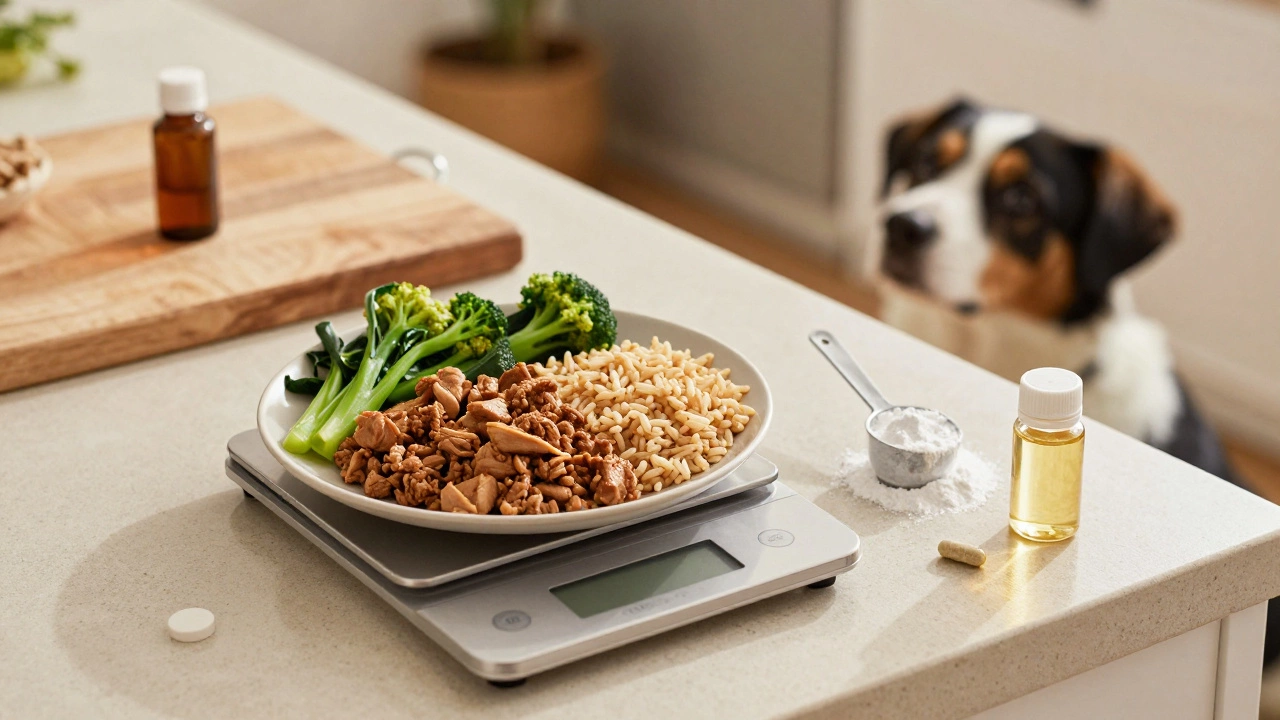You look at that never-ending row of dog food bags at the store, and it’s easy to get overwhelmed. There’s Purina everywhere, and then there’s IAMS: both big brands, both shouting about healthy dogs and happy lives. But which one actually deserves a spot in your shopping cart?
If you’re like most dog owners, you want to feed your dog good stuff without blowing your budget or accidentally giving them an upset stomach. Ingredient lists and promises on the bag can be confusing—or flat-out misleading—so let's clear up some of the noise right away. Purina and IAMS aren't gourmet boutique brands, but they're both major players with long histories. That matters, because with food recalls and quality concerns in the news every year, buying from a company that’s been around the block actually counts for something.
One crazy fact: more dogs in the US eat Purina products than any other brand, according to 2024 supermarket sales data. IAMS has a smaller share, but some vets like their specialty formulas for picky or sensitive dogs. So how do you really figure out which food (and which bag!) is right for your dog? Get ready to find out what’s behind the labels—and why it all matters a lot more than that shiny packaging.
- Ingredient Quality: What’s Really Inside?
- Nutritional Value: Reading the Labels
- Special Diets and Breed Needs
- Cost and Where to Buy
- Expert Opinions and Real Dog Owner Reviews
- Tips for Switching Dog Food Safely
Ingredient Quality: What’s Really Inside?
This is where things get real. Flip a bag of Purina or IAMS over, and you'll see a wall of ingredients—some you recognize, some that sound like a science experiment. Let’s break down what they actually mean for your dog.
Packed into both brands are animal proteins, grains, by-products, and a long list of vitamins and minerals. Here’s the deal: neither Purina nor IAMS markets itself as a fancy boutique brand using only raw or organic stuff. Most formulas use chicken or beef as their main animal protein, but you’ll also find meal (like “chicken meal” or “fish meal”). That’s just protein cooked down for higher protein punch—completely safe and very normal in most kibble. Both brands use grains, mainly corn and wheat. If your dog has legit allergies, look for the ‘grain-free’ options in both lines, but don’t believe the hype that all dogs need grain-free food (most don’t, and vets actually warn against grain-free foods for some breeds).
What about fillers? That’s a loaded word. Corn and wheat get a bad rap, but they’re not harmful for most dogs and actually offer energy. By-products sound scary but are simply clean parts of animals (like organ meat) that dogs love and get nutrients from. Neither brand slips in harmful fillers or mysterious labeled ingredients, which is good news.
Look at the table below to see a quick ingredient face-off between a standard Purina and IAMS adult chicken formula, according to their 2025 packaging:
| Brand | First 5 Ingredients | Notable Additions |
|---|---|---|
| Purina Dog Chow | Corn, Meat and Bone Meal, Corn Gluten Meal, Beef Fat, Soybean Meal | Vitamins, minerals, color added |
| IAMS ProActive Health | Chicken, Ground Whole Grain Corn, Ground Whole Grain Sorghum, Chicken By-Product Meal, Dried Beet Pulp | Vitamins, minerals, prebiotics |
IAMS typically starts its ingredient list with actual chicken, while Purina sometimes leads with corn or meal—something to think about if you want straight-up meat at the top. On the flip side, both throw in real meat further down the list and add nutrients for balance.
- If your dog’s got allergies, always skim for things like soy, wheat, or chicken (or find their grain-free line).
- If you want more meat, pick formulas that have meat as the first ingredient—easy to do with IAMS, but Purina does have lines like “Purina ONE” that feature meat at the top too.
- Neither brand includes dangerous artificial preservatives like BHA or ethoxyquin in their main lines anymore as of 2025.
If “premium” is your goal, you’ll have to look higher up the price ladder, but between these two, Purina and IAMS stick solidly to safe, basic ingredients that most vets give the nod to for basic nutrition.
Nutritional Value: Reading the Labels
If you just flip over a bag of dog food and read the fine print, you’ll see a bunch of percentages—protein, fat, fiber, and moisture. But what does all that mean in real life? For most healthy adult dogs, you want their food to hit at least 18% protein and around 8% fat, according to the Association of American Feed Control Officials (AAFCO) guidelines. Both Purina and IAMS meet those minimums, and most of their adult formulas actually go beyond them.
Here’s the thing to look for right away: what’s the first ingredient? Purina’s popular Pro Plan and ONE lines often start with a real meat (like chicken), while lower-end options like Dog Chow might list corn first. IAMS, especially in their ProActive Health formulas, also starts with real meat a lot of the time, and usually keeps the plant fillers lower. It’s not just about protein though—meat as the first ingredient usually means better quality nutrients for your pup. But both brands do have some recipes that sneak in things like corn, by-products, or wheat early on, so check each flavor separately.
Carbohydrates are a gray area. Dogs don’t actually need them, but carbs make kibble crunchy and boost calories. Purina and IAMS both use corn, wheat, or rice, which isn’t “bad” unless your dog’s got allergies or sensitivities. High fiber—like 4% or more—can help with digestion in dogs who have loose stools, but it’s not always great for super active pups who need more calories.
Here’s a quick cheat sheet for reading dog food labels:
- Look for meat (chicken, beef, lamb, salmon) as ingredient #1.
- Hunt for familiar ingredients. If you can’t picture it, maybe don’t feed it.
- For puppies, make sure there’s DHA and higher protein (over 22%).
- Skip artificial dyes and lots of chemical-sounding preservatives if possible.
Check for an AAFCO statement—this tells you the food meets minimum nutrition for a dog’s life stage (puppy, adult, senior). Both Purina and IAMS are formulated to hit these, which is a huge reason why most vets are cool with both.
Bottom line: both brands offer legit nutrition, but reading the actual bag matters more than the logo or TV commercials. Always match the ingredients and nutrients on the label to your dog’s age, size, and any allergies or health issues you know about.
Special Diets and Breed Needs
Not all dogs thrive on the same food, even if the bags look similar. Some pups have sensitive stomachs, others are super active, and certain breeds deal with allergies more often. So, let’s get into how Purina and IAMS stack up for dog food options tailored to those different needs.
Purina actually offers one of the biggest choices if your dog has specific health needs. Their "Pro Plan" line covers just about everything—grain-free, sensitive skin and stomach, weight management, plus breed-specific recipes. They even make formulas for puppies, seniors, and working dogs. Purina’s Focus Sensitive Skin & Stomach Salmon & Rice formula, for example, is a go-to for dogs that can’t handle chicken or common grains. Fun fact: about 17% of dog parents switch to a specialty or "sensitive" formula after their dog turns two, according to a 2023 Pet Food Institute report.
IAMS isn’t as broad but still covers the basics well. They have special blends for puppies, adult dogs, and seniors. If you have a breed with a faster metabolism (like a Jack Russell or a German Shepherd), IAMS’ High Protein formula can help keep up with their energy. They also offer "Healthy Weight" formulas if your dog needs to slim down. Their "ProActive Health" line gets noticed by owners dealing with skin, coat, or digestion issues, and IAMS has a unique prebiotic fiber addition to help with gut health.
"For dogs that have allergies or sensitive tummies, ingredient quality and targeted nutrition can make a world of difference. Look for foods labeled for ‘sensitive systems’ or formulas that match your dog’s age, size, and breed." — Dr. Jenna Webber, DVM, featured in Canine Nutrition Monthly
Puppy, adult, or senior? Both brands spell out the age range clearly right on the front, which is helpful. But Purina wins with more breed-size options: small breed, large breed, and even recipes meant for toy breeds or giant dogs.
Here’s a quick comparison of their specialty choices, so you can see who does what:
| Brand | Puppy | Senior | Grain-Free | Weight Control | Breed-Specific |
|---|---|---|---|---|---|
| Purina | Yes | Yes | Yes | Yes | Yes |
| IAMS | Yes | Yes | Limited | Yes | No |
Bottom line: If your dog has basic needs (like being a typical adult Labrador), either brand has you covered. But if your pup’s a diva with lots of dietary quirks, Purina’s lineup just has more options to try. Never hurts to check labels, though—sometimes even the same "sensitive" formula lists different main ingredients depending on the bag size or region. When in doubt, ask your vet what’s best for your specific breed and health situation.

Cost and Where to Buy
Let’s talk dollars and sense. No one wants to pay more than they have to for dog food, but we also don’t want to cut corners on our pups’ health. When you stack up Purina and IAMS, the price difference isn’t gigantic, but it’s noticeable if you’re buying month after month.
Here’s a quick side-by-side for some of the most popular formulas as of June 2025:
| Brand | Product | Bag Size (lbs) | Average Price ($) | Price per lb ($) |
|---|---|---|---|---|
| Purina | Purina ONE Chicken & Rice | 16.5 | 28.99 | 1.76 |
| IAMS | IAMS Minichunks | 15 | 24.99 | 1.67 |
| Purina | Pro Plan Sensitive Skin & Stomach | 16 | 38.99 | 2.44 |
| IAMS | IAMS Healthy Weight | 15 | 27.99 | 1.87 |
IAMS sometimes comes out a bit cheaper per pound, but Purina has more sales and coupons floating around, so keep an eye out. Purina also has a wider range of options, from basic to “premium” lines like Pro Plan, which can push the price up fast. But you’re also getting more choices, and that’s handy if your dog needs grain-free or sensitive digestion formulas.
Where you shop will tip the balance. IAMS tends to show up more in supermarkets, big-box stores (think Walmart), and pet stores. Purina is literally everywhere—supermarkets, small local shops, pet stores, big chains, even wholesale clubs like Costco. If you prefer to buy online, you’ll find both brands on Amazon, Chewy, PetSmart, and Walmart.com. Just compare prices—sometimes a 40-lb bag online is a better bargain even after shipping.
Some pro tips to save money:
- Sign up for loyalty programs at Petco or PetSmart—repeat buyers get regular discounts.
- Check both brands’ official websites for printable coupons.
- If your dog eats a lot, look for big bags at warehouse clubs or shop online in bulk. Per-pound, it’s usually much less.
- Watch for auto-ship promos on sites like Chewy or Amazon Subscribe & Save—you get extra discounts and don’t have to lug heavy bags from the store.
Bottom line: you aren’t locked in to one price or one store. With a little hunting, both Purina and IAMS can fit most budgets without making you compromise on your dog’s daily meals.
Expert Opinions and Real Dog Owner Reviews
If you really want to know how good a dog food is, get past the ads and look at what vets and everyday pet owners are saying. Both Purina and IAMS regularly pop up in vet recommendations, but the details make all the difference.
Veterinarians often lean toward Purina—for example, the Purina Pro Plan line has shown up on the "top recommended" lists from the American Veterinary Medical Association in 2024. That's mostly because Purina funds a lot of research and offers nutrition guided by animal scientists. Vets say it shows in their formulas, especially for active or working dogs.
IAMS has a bit of a different reputation. Their formulas get praise for dogs with sensitive stomachs or itchy skin, especially the IAMS Healthy Naturals and IAMS ProActive Health lines. Several smaller animal hospitals (like Oak Tree Veterinary in Michigan) reported in their reviews that switching to IAMS helped some allergy-prone pups when other foods didn't.
What about actual owners—folks who have scooped this kibble into real bowls, day after day? Thousands leave feedback online, and you get a mixed but honest picture. Here’s a quick look at ratings tallied up from Chewy, Amazon, and PetSmart in early 2025 for some top products:
| Product | Avg. Rating | # of Reviews | Common Praise | Common Complaints |
|---|---|---|---|---|
| Purina Pro Plan Adult | 4.7/5 | 18,000+ | Easy digestion, shiny coat | Price, picky eaters |
| IAMS ProActive Health Adult | 4.6/5 | 9,000+ | Helps skin, fewer tummy issues | Picky eaters, bag size |
| Purina ONE SmartBlend | 4.5/5 | 24,000+ | Good value, visible results | Crumbs/dust in bag |
| IAMS Minichunks | 4.4/5 | 12,000+ | Small kibble size, liked by seniors | Transition issues, strong smell |
If you’re worried about recalls, neither brand is perfect but both score better than most in recall history. Both Purina and IAMS had minor voluntary recalls in 2022, but nothing widespread or harmful in recent years. That’s honestly a big relief for most owners.
So, what does all this mean? If you want a food with a vet-backed reputation and a proven track record for most dogs—including working breeds—Purina takes the lead. But if your dog has a sensitive system or you need a more affordable option that still keeps tails wagging, IAMS holds its own. Absolutely check the ingredients and reviews for your dog's age and size.
Tips for Switching Dog Food Safely
No matter how great the new food looks, switching things up too fast can leave your dog with an upset stomach, messy poops, or worse. The trick is taking it slow and knowing what signs of trouble look like. A sudden dog food swap is actually one of the top causes of digestive issues reported by vets in 2024. Want the short version? Go slow, watch closely, and be ready to pause if your dog reacts poorly.
“For most dogs, transitioning to a new food over seven to ten days gives their digestive system time to adjust and can prevent most tummy troubles,” says Dr. Amy Farley, DVM, a board-certified veterinary nutritionist.
Here’s a step-by-step, vet-approved way to switch up your dog's diet, whether you’re moving from IAMS to Purina, the other way around, or any other brand:
- Day 1-2: Mix about 25% of the new food with 75% of the old food.
- Day 3-4: Go half and half—mix equal parts old and new.
- Day 5-6: Bump it up to 75% new food and 25% old food.
- Day 7 and beyond: Feed only the new food (if everything’s going well).
Here’s what to watch for: normal poop, steady energy, and no vomiting are good signs. But keep your eyes peeled for runny stool, loss of appetite, or itching—those could be signs your dog isn’t handling the switch.
| Day | Old Food (%) | New Food (%) |
|---|---|---|
| 1-2 | 75 | 25 |
| 3-4 | 50 | 50 |
| 5-6 | 25 | 75 |
| 7+ | 0 | 100 |
If your dog has a very sensitive stomach or has had tummy issues before, you might need to stretch this out to two weeks. And remember—always keep an extra bag of your old food handy just in case you need to slow down. If things really go south—your dog stops eating, you see blood in the stool, or vomiting doesn’t stop—call your vet. Safety comes first.
Bottom line: Whether you’re moving to Purina, IAMS, or something else, patience and a watchful eye make all the difference.








